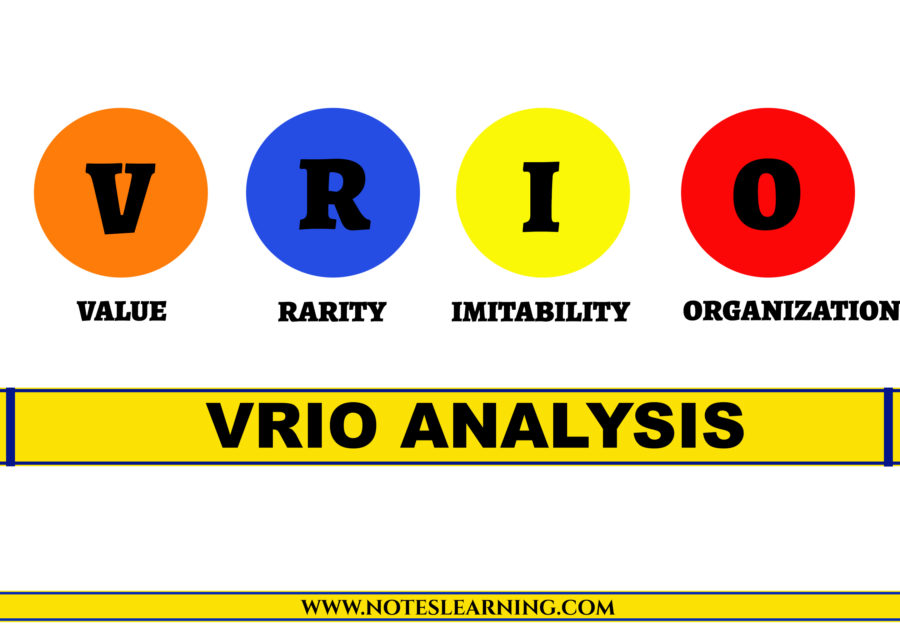INTRODUCTION
VRIO Analysis or VRIO Framework is an analytical tool in the strategic planning and formulation which enables assessment, analysis and evaluation of the available resources and capabilities of the company (organization) to determine the competitive advantage of the company (organization).
VRIO Framework was first developed by Jay B. Barney in 1991 in his work titled “ Firm Resources and Sustained Competitive Advantage”, to evaluate the micro-environments of the organization. All the resources are evaluated on the basis of value, rarity, imitability and organization’s preparedness.

VRIO framework is the foundation for accomplishing internal analysis and this framework is the integration of positioning perspective and the resource-based view.
The ability of the organization to analyze and identify the VRIO resources explains and reflects the competitive position.
Valuable
A resource or capability is said to be valuable resources if it allows the firms to improve the company’s efficiency and effectiveness by exploiting the opportunities and neglecting the possible threats in the business. The resources which don’t fulfill the condition may lead to competitive disadvantages.
For Example: Union Pacific has an extensive network of rail-line property and equipment across the Gulf Coast and United States is valuable as it allows the company to provide a cost effective way to transport chemicals.
Rarity
Rarity means the uniqueness in the available resources. Resources that are acquired by very few companies are considered rare and hold of such rare resources is considered to provide competitive parity. Availability of similar resources will allow every firm to adapt and implement similar strategies.
A company might have valuable resources but the resources might not be commonly held hence such resources do not create any competitive advantage.
For example: Coca Cola is a valuable brand but the resources available with the Coca Cola Company is not rare hence we Coca Cola has competition from Pepsi, RCs etc.
Imitability
Imitability of the resources is concerned with the long-term competitive advantage of the company. If the resources available in the organization can be easily duplicated or imitated, then such resources do not provide competitive advantage in long-term. For resources to be competitive, the cost of imitability should be very high. If the resources are imitable, in this competitive business environment, it won’t take much for competitors to share the market in the respective environment. Basically, there are three factors which makes any resources difficult to imitate when;
- If the resources are of unique Historical Importance with limited access.
- If the resources are based on the human competencies, interpersonal relations, a company’s culture and reputation.
- If the association between the resources and company’s operation is unknown which makes it difficult for the competitors to imitate.
Organization
The last factor of the VRIO framework is organizational capability. The availability of the resources couldn’t be well utilized if the organization is incapable of handling and exploiting those resources. Ownership, organizational leadership, norms and culture, human resources, management systems, processes, structure, financial capability etc. should complement the available resources.
Resources can be imitable but the competencies with the organization to exploit those resources is difficult to imitate.
For example: The success story of most of the companies is backed up by successful organizational operation. Google is an IT based company hence the IT infrastructure along with its Human resources make Google a highly competitive company. Similarly, Walmart’s supply chain and distribution channel make the company highly competitive.
| V Valuable | R Rarity | I Imitability | O Organization | |
| No | Competitive Disadvantage | |||
| Yes | No | Competitive Parity | ||
| Yes | Yes | No | Temporary Competitive Advantage | |
| Yes | Yes | Yes | No | Unused Competitive Advantage |
| Yes | Yes | Yes | Yes | Sustainable Competitive Advantage |
The above table represents the VRIO framework and how these VRIO factors reflect the competitive position. There is no competitive advantage if resources do not have any VRIo factor. Similarly if the resources are only valuable then such resources provide competitive parity i.e. the company with valuable resources can have the standards or performance level close to the industry average.
Similarly, valuable resources with rarity provides temporary competitive advantage. When resources are inimitable, it provides unused competitive advantage. Finally, if all the VRIO framework stand out, it leads to sustainable competitive advantages.
References

